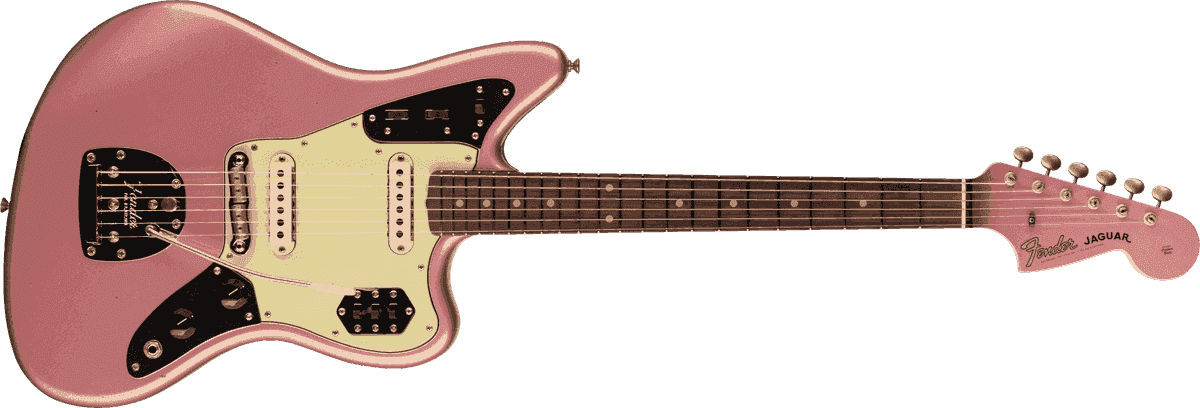Jaguar Tremolo Setup - Balance, Trem‑Lock, Tuning Stability
Learn to set up your Fender Jaguar's unique floating tremolo system. This guide covers balancing the tremolo, using the trem-lock, and tips for improving tuning stability for smooth, reliable vibrato.
The Fender Jaguar has one of the most expressive (and misunderstood) tremolo systems. When set up correctly, it offers a smooth, subtle vibrato unlike any other. This guide covers how to balance the spring tension, use the trem-lock, and achieve solid tuning stability.
For a complete Jaguar setup, see our Ultimate Fender Jaguar Setup Guide.
Quick Tips: Jaguar Tremolo Stability
- Verify Jaguar neck relief at 0.010–0.012 in and set string height around 1.5–2.0 mm before balancing the tremolo.
- Reduce friction by lubricating nut slots and bridge saddles; pickup height that’s too close can also pull strings sharp.
- Use the trem‑lock to hold pitch during string changes and as a safety if a string breaks mid‑set.
How the Jaguar Tremolo Works
Unlike a Stratocaster, the Jaguar tremolo is a floating system with a separate bridge. The entire unit pivots on a knife edge. The key is balancing the tension of your strings with the single spring located in the tremolo cavity.
Balancing the Tremolo
- Tune to Pitch: Start with your guitar tuned to your preferred tuning with a reliable tuner like the Boss TU-3 Chromatic Tuner.
- Adjust the Spring Tension: The tension is adjusted via a single screw on the tremolo plate.
- Tightening the screw increases spring tension, pulling the tremolo arm down and causing the pitch to go sharp.
- Loosening the screw decreases spring tension, allowing the strings to pull the tremolo arm up, causing the pitch to go flat.
- Find the Balance Point: The goal is to find the point where the string tension and spring tension are equal. You'll know you're there when the tremolo returns to pitch after use. Make small adjustments and retune until it's stable.
Spring Tension and Bridge Interaction
- Tune to pitch (use a precise tuner like the Boss TU‑3).
- Adjust tremolo spring tension so the arm has smooth resistance and returns to the same pitch.
- Coordinate with bridge height and saddle stability. If the bridge rocks excessively or rattles, stability suffers.
- Ensure strings are well seated in saddles; heavier gauges (e.g., 10–46 or 11–49) help. A set like Ernie Ball Regular Slinky 10–46 is a solid baseline for offsets.
Using the Trem-Lock
The Jaguar trem-lock is a unique feature that allows you to lock the tremolo in a "down" position.
- Engage the Lock: Push the tremolo arm down and slide the trem-lock button towards the neck. When you release the arm, the tremolo will be locked. This is useful for string changes or if a string breaks, which would otherwise cause the guitar to go wildly out of tune.
- Setting the Lock Point: The trem-lock's position can be adjusted. With the tremolo unlocked, use a small screwdriver to turn the screw inside the trem-lock button's hole. This sets how far down the tremolo locks. A common setup is to have it lock at the point where the pitch is a semitone or whole tone lower.
Tips for Tuning Stability
- Neck Angle is Key: A proper neck shim is often necessary on a Jaguar to increase the break angle over the bridge. This puts more downward pressure on the bridge, improving sustain and stability.
- Bridge Matters: The stock "threaded saddle" bridge can cause issues. Consider an upgrade to a Mustang-style bridge or a dedicated aftermarket option like the Fender American Professional Jaguar Bridge for better stability.
- Lubricate Contact Points: Use a lubricant like MusicNomad TUNE‑IT on the nut slots and bridge saddles to reduce friction.
- Proper Stringing Technique: Ensure your strings are stretched properly and wound correctly on the tuning posts.
Return-to-Pitch Checklist
- Lubricate contact points (nut slots, saddle grooves, pivot points) with MusicNomad TUNE‑IT.
- Set clear witness points at nut and saddles after tuning.
- Verify the bridge is properly seated in the thimbles and height screws aren’t loose.
- Balance tremolo spring tension to match string tension at pitch (turn evenly using a D'Addario Multi‑Tool).
- Use the lock as a consistent return stop.
FAQ
Why won't my Jaguar stay in tune?
The most common culprits are insufficient break angle over the bridge (needs a neck shim), friction at the nut or bridge, or an imbalanced tremolo.
Should I set the bridge to rock or lock it down?
The classic design rocks; many players prefer upgraded bridges for stability while preserving feel. Try stock first, then consider upgrades if needed.
What string gauges work best?
10–46 or 11–49 improve stability on offsets and reduce saddle jumping. A set like Ernie Ball Regular Slinky 10–46 (Ernie Ball Regular Slinky Nickel Wound Electric Guitar Strings) is a reliable baseline.
Do I need an aftermarket bridge?
Not always. A well‑set stock bridge can work. If issues persist, consider Mastery/Staytrem/Mustang‑style options (e.g., Mastery Bridge).
How tight should the trem spring be?
Tight enough that the arm returns to the same pitch with light use and the lock engages/disengages with slight resistance at pitch.
Can the lock be used as a hard stop for vibrato?
It’s designed as a return/parking aid, not a dive‑stop. Use gently for consistent return rather than hard stops.
What is the trem-lock for?
It locks the tremolo, preventing it from moving. This is useful for maintaining tuning if a string breaks, and for quick string changes.
Should I upgrade my Jaguar's bridge?
If you're experiencing tuning instability or buzzing that you can't solve with a good setup, a bridge upgrade is a common and effective solution.
Related Guides
- Main: Ultimate Fender Jaguar Setup Guide
- Also see: Jaguar Truss Rod Adjustment Guide
Related Posts
Jaguar-Specific Guides
- Ultimate Jaguar Setup Guide - Complete setup process and specifications
- Jaguar Truss Rod Adjustment - Detailed neck relief adjustment techniques
- Jaguar String Gauge Selection Guide - Action height and string gauge selection
Other Fender Guitar Setup Guides
- Telecaster Setup Guide - Complete Telecaster setup process
- Stratocaster Setup Guide - Complete Stratocaster setup process
- Stratocaster Tremolo Setup - Stratocaster tremolo configuration
- Jazzmaster Setup Guide - Jazzmaster-specific setup procedures

